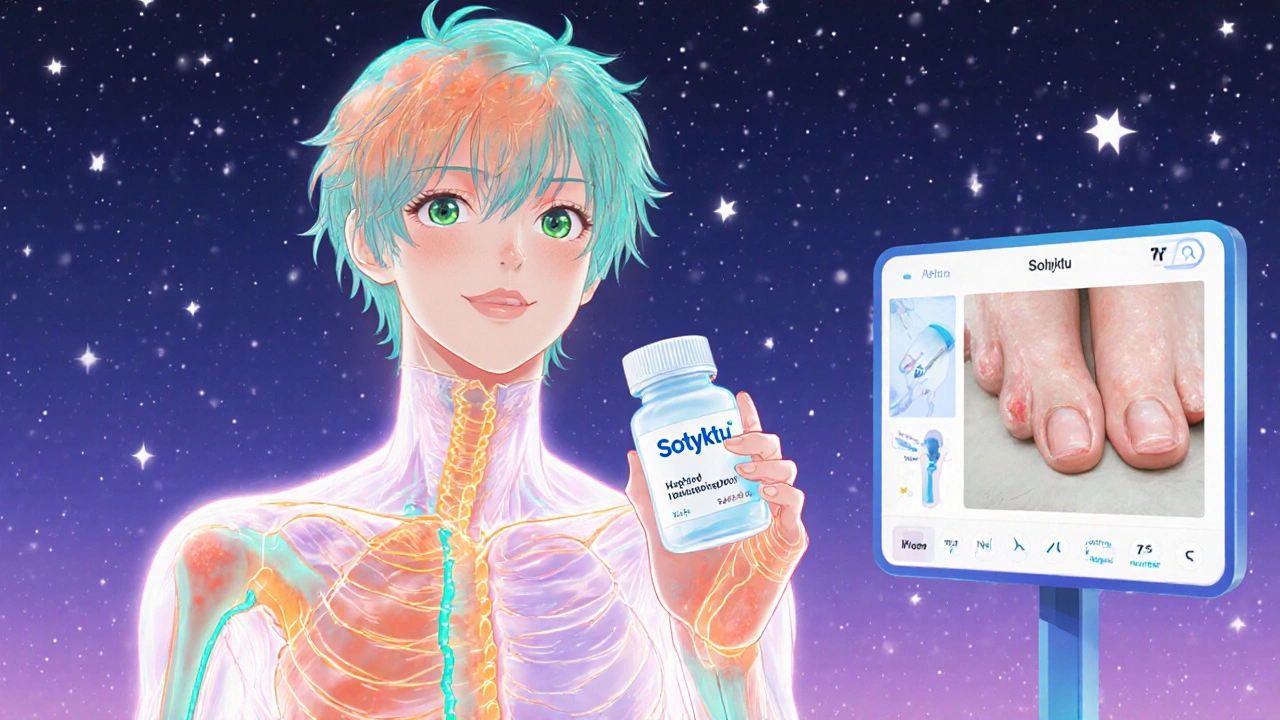When your skin breaks out in red, scaly patches and your fingers or knees suddenly swell up with pain, it’s not just two separate problems. It’s one condition wearing two masks. Psoriatic arthritis doesn’t just affect your joints - it’s tied directly to the psoriasis on your skin. And if you ignore the link, you risk permanent joint damage before you even realize what’s happening.
How Skin and Joints Are Connected
Psoriatic arthritis is an autoimmune disease. That means your immune system, which should protect you, starts attacking your own body. It doesn’t pick just one target - it hits both your skin and your joints at the same time. The same inflammatory signals that cause thick, flaky plaques on your elbows or scalp also trigger swelling and pain in your fingers, toes, knees, or spine. About 30% of people with psoriasis will develop psoriatic arthritis. For most, the skin comes first - often years before joint pain starts. But in 15% of cases, joint symptoms show up before any visible skin changes. That’s why doctors now look at nails, too. Pitting, crumbling, or lifting of the nail (called onycholysis) happens in 80-90% of people with psoriatic arthritis. It’s one of the clearest red flags. Unlike rheumatoid arthritis, which usually hits both sides of the body symmetrically (both wrists, both knees), psoriatic arthritis is often uneven. You might have swelling in your right index finger and your left knee, but nothing on the left side. This asymmetry is a key clue. So is dactylitis - when an entire finger or toe swells up like a sausage. That’s not just arthritis. It’s inflammation deep in the tendon sheath, and it’s unique to psoriatic arthritis and a few other spondyloarthropathies.Five Types of Psoriatic Arthritis - And What They Mean
Not everyone experiences psoriatic arthritis the same way. There are five main patterns, each affecting different joints and requiring slightly different approaches:- Asymmetric oligoarthritis - The most common type, affecting 70% of patients. One to four joints are involved, often in an irregular pattern. This is where you might notice one ankle swelling up while your other foot feels fine.
- Symmetric polyarthritis - Affects about 25% of people. Looks a lot like rheumatoid arthritis because it hits matching joints on both sides. But unlike rheumatoid, it usually doesn’t show up in blood tests.
- Distal interphalangeal predominant (DIP) - Hits the joints closest to the nails. If you’ve got pitted nails and stiff knuckles near the fingertips, this is likely the culprit. Only 5% of cases, but very telling.
- Spondylitis - Involves the spine and lower back. About 5-20% of patients develop this. It’s not the same as ankylosing spondylitis, but it causes similar stiffness, especially in the morning.
- Arthritis mutilans - The rarest and most destructive form. Less than 5% of cases. It eats away at the bones, causing shortening and deformity of fingers or toes. Early treatment can prevent this.
Signs You Might Have It - Even If You Don’t Think You Do
Many people dismiss early symptoms. They think, “It’s just sore from working out,” or “My nails are brittle because I wash dishes too much.” But here are the signs you can’t ignore:- Swelling in one or more fingers or toes - especially if it looks like a sausage
- Stiffness in the morning that lasts more than 30 minutes
- Pain in the heels or soles of the feet - often from enthesitis, where tendons attach to bone
- Lower back pain that improves with movement, not rest
- Nail changes: pits, ridges, separation from the nail bed, or yellow-brown discoloration
- Joint pain that doesn’t match typical osteoarthritis - it flares up and settles, often without injury
Treatment: It’s Not One Size Fits All
There’s no cure - but there are powerful tools to stop the damage and get your life back. The goal isn’t just to reduce pain. It’s to reach “minimal disease activity,” meaning you’re not just feeling better - your joints are quieting down, your skin is clearing, and your body isn’t being eaten from the inside. Conventional drugs like methotrexate or sulfasalazine have been used for decades. They work for some, but slowly. And they don’t always help the skin. Biologics are the game-changers. These are injectable or infused drugs that block specific parts of the immune system driving the inflammation. They include:- TNF inhibitors - adalimumab (Humira), etanercept (Enbrel), infliximab (Remicade). These were the first biologics approved for psoriatic arthritis and still make up over half of prescriptions.
- IL-17 inhibitors - secukinumab (Cosentyx), ixekizumab (Taltz). Great for both skin and joints.
- IL-23 inhibitors - guselkumab (Tremfya), risankizumab (Skyrizi). Often work faster and keep symptoms away longer.
- TYK2 inhibitor - deucravacitinib (Sotyktu). First oral pill approved for psoriatic arthritis in 2022. No injections needed.
The Team Approach: Dermatologist + Rheumatologist
You can’t treat this with one doctor alone. A dermatologist sees your skin. A rheumatologist sees your joints. But together, they see the whole picture. About 45% of psoriatic arthritis cases are first spotted by dermatologists. That’s why if you have moderate-to-severe psoriasis, your dermatologist should be asking about joint pain - even if you didn’t mention it. Effective treatment plans involve coordination between these specialists, physical therapy, and sometimes occupational therapy. Physical therapists teach you how to move without stressing damaged joints. Occupational therapists help you adapt daily tasks - opening jars, typing, gripping things - so you don’t wear out your hands.
What You Can Do Right Now
If you suspect you have psoriatic arthritis:- Write down every symptom - skin patches, joint pain, stiffness, nail changes - and when they started.
- Take photos of your skin and swollen joints. Visuals help doctors spot patterns.
- Ask your dermatologist for a referral to a rheumatologist. Don’t wait for your primary care doctor to notice.
- Get tested for TB and hepatitis before starting biologics - it’s required by the FDA.
- Track your triggers. Stress, infections, alcohol, and even certain foods can spark flares. Keep a simple journal.
The Future Is Getting Brighter
In 2023, researchers at UC San Francisco developed an AI tool that can predict who’ll develop psoriatic arthritis from psoriasis with 87% accuracy - using just nail photos and joint scans. That means earlier intervention. New oral drugs like upadacitinib (a JAK inhibitor) are in late-stage trials and could be available by late 2024. By 2028, genetic testing may tell you which drug will work best for you - cutting out years of trial and error. But the biggest breakthrough isn’t a new pill. It’s awareness. More people are learning that psoriasis isn’t just a skin problem. It’s a warning sign. And catching it early can save your joints - and your future.Common Questions
Can psoriatic arthritis happen without skin psoriasis?
Yes, in about 15% of cases, joint symptoms appear before any visible skin changes. That’s why doctors look for nail pits, enthesitis (tendon inflammation), and dactylitis - even if the skin looks normal. If you have unexplained joint pain and a family history of psoriasis, you should still be tested.
Is psoriatic arthritis the same as rheumatoid arthritis?
No. Rheumatoid arthritis usually affects joints symmetrically and shows up in blood tests (like rheumatoid factor). Psoriatic arthritis is often asymmetric, rarely shows up in blood tests, and is linked to skin and nail changes. It also causes dactylitis and enthesitis - features that don’t occur in rheumatoid arthritis.
Do biologics cure psoriatic arthritis?
No, they don’t cure it. But they can stop the disease from progressing. Many patients achieve long-term remission - meaning no pain, no swelling, no new damage. Stopping treatment often leads to flare-ups, so most people stay on biologics long-term under medical supervision.
Why do some people get worse skin after starting psoriatic arthritis treatment?
Some biologics, especially TNF inhibitors like etanercept, can trigger new or worse psoriasis in a small number of patients. This isn’t a failure of the drug - it’s a side effect. Switching to an IL-17 or IL-23 inhibitor often clears up both the joints and the skin. Your rheumatologist can adjust your treatment plan.
How long does it take for psoriatic arthritis treatment to work?
It varies. Oral medications like methotrexate can take 6-12 weeks. Biologics like guselkumab or secukinumab often show improvement in 4-8 weeks. Some patients feel better in days with newer oral drugs like Sotyktu. But full control - meaning no swelling, no fatigue, no damage - can take 3-6 months. Patience and consistency matter.
Can I stop treatment if my symptoms disappear?
Don’t stop without talking to your doctor. Even if you feel fine, inflammation may still be quietly damaging your joints. Stopping treatment increases the risk of flare-ups and permanent damage. Some patients can reduce dosage under close monitoring, but complete withdrawal is rarely safe.







